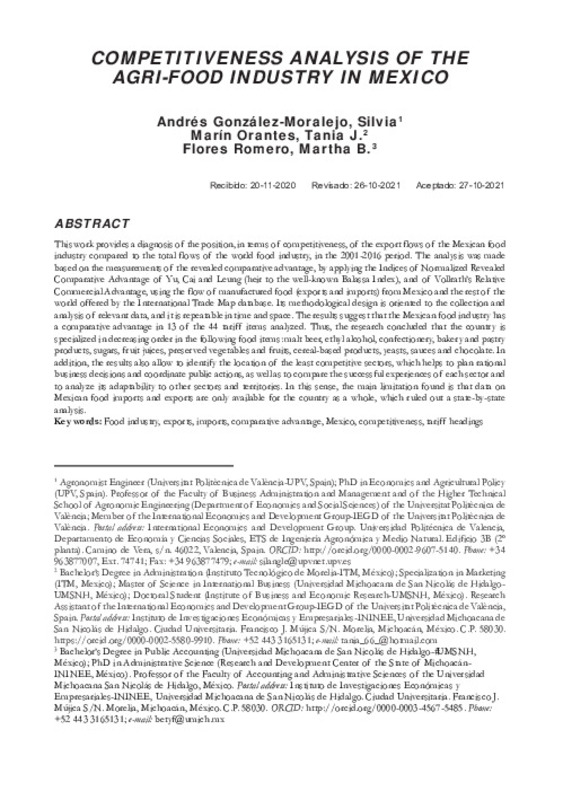JavaScript is disabled for your browser. Some features of this site may not work without it.
Buscar en RiuNet
Listar
Mi cuenta
Estadísticas
Ayuda RiuNet
Admin. UPV
COMPETITIVENESS ANALYSIS OF THE AGRI-FOOD INDUSTRY IN MEXICO
Mostrar el registro sencillo del ítem
Ficheros en el ítem
| dc.contributor.author | Andrés González-Moralejo, Silvia
|
es_ES |
| dc.contributor.author | Marín Orantes, Tania
|
es_ES |
| dc.contributor.author | Flores Romero, Martha
|
es_ES |
| dc.date.accessioned | 2022-07-12T18:04:45Z | |
| dc.date.available | 2022-07-12T18:04:45Z | |
| dc.date.issued | 2021 | es_ES |
| dc.identifier.issn | 1316-0354 | es_ES |
| dc.identifier.uri | http://hdl.handle.net/10251/184033 | |
| dc.description.abstract | [EN] This work provides a diagnosis of the position, in terms of competitiveness, of the export flows of the Mexican food industry compared to the total flows of the world food industry, in the 2001-2016 period. The analysis was made based on the measurements of the revealed comparative advantage, by applying the Indices of Normalized Revealed Comparative Advantage of Yu, Cai and Leung (heir to the well-known Balassa Index), and of Vollrath¿s Relative Commercial Advantage, using the flow of manufactured food (exports and imports) from Mexico and the rest of the world offered by the International Trade Map database. Its methodological design is oriented to the collection and analysis of relevant data, and it is repeatable in time and space. The results suggest that the Mexican food industry has a comparative advantage in 13 of the 44 tariff items analyzed. Thus, the research concluded that the country is specialized in decreasing order in the following food items: malt beer, ethyl alcohol, confectionery, bakery and pastry products, sugars, fruit juices, preserved vegetables and fruits, cereal-based products, yeasts, sauces and chocolate. In addition, the results also allow to identify the location of the least competitive sectors, which helps to plan rational business decisions and coordinate public actions, as well as to compare the successful experiences of each sector and to analyze its adaptability to other sectors and territories. In this sense, the main limitation found is that data on Mexican food imports and exports are only available for the country as a whole, which ruled out a state-by-state analysis. | es_ES |
| dc.language | Inglés | es_ES |
| dc.publisher | UNIVERSIDAD DE LOS ANDES VENEZUELA | es_ES |
| dc.relation.ispartof | Agroalimentaria | es_ES |
| dc.rights | Reserva de todos los derechos | es_ES |
| dc.subject | Food industry | es_ES |
| dc.subject | Exports | es_ES |
| dc.subject | Imports | es_ES |
| dc.subject | Comparative advantage | es_ES |
| dc.subject | Mexico | es_ES |
| dc.subject | Competitiveness | es_ES |
| dc.subject | Tariff headings | es_ES |
| dc.subject.classification | ECONOMIA, SOCIOLOGIA Y POLITICA AGRARIA | es_ES |
| dc.title | COMPETITIVENESS ANALYSIS OF THE AGRI-FOOD INDUSTRY IN MEXICO | es_ES |
| dc.type | Artículo | es_ES |
| dc.rights.accessRights | Abierto | es_ES |
| dc.contributor.affiliation | Universitat Politècnica de València. Departamento de Economía y Ciencias Sociales - Departament d'Economia i Ciències Socials | es_ES |
| dc.description.bibliographicCitation | Andrés González-Moralejo, S.; Marín Orantes, T.; Flores Romero, M. (2021). COMPETITIVENESS ANALYSIS OF THE AGRI-FOOD INDUSTRY IN MEXICO. Agroalimentaria. 27(52):125-140. http://hdl.handle.net/10251/184033 | es_ES |
| dc.description.accrualMethod | S | es_ES |
| dc.relation.publisherversion | http://erevistas.saber.ula.ve/index.php/agroalimentaria | es_ES |
| dc.description.upvformatpinicio | 125 | es_ES |
| dc.description.upvformatpfin | 140 | es_ES |
| dc.type.version | info:eu-repo/semantics/publishedVersion | es_ES |
| dc.description.volume | 27 | es_ES |
| dc.description.issue | 52 | es_ES |
| dc.relation.pasarela | S\460461 | es_ES |
| dc.subject.ods | 02.- Poner fin al hambre, conseguir la seguridad alimentaria y una mejor nutrición, y promover la agricultura sostenible | es_ES |
| dc.subject.ods | 09.- Desarrollar infraestructuras resilientes, promover la industrialización inclusiva y sostenible, y fomentar la innovación | es_ES |
| dc.subject.ods | 10.- Reducir las desigualdades entre países y dentro de ellos | es_ES |






